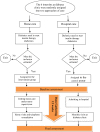Health Economic Evaluation of Home and Hospital-Based Care in T2D Patients on Insulin Therapy
- PMID: 29487474
- PMCID: PMC5811944
- DOI: 10.4314/ejhs.v27i6.10
Health Economic Evaluation of Home and Hospital-Based Care in T2D Patients on Insulin Therapy
Abstract
Background: Type 2 Diabetes is a main concern of public health in contemporary world with remarkable mortality, delayed complications and health costs. Governments are obliged to improve the quality of health care and consider appropriate strategies to reduce the costs. An alternative strategy for hospital services is care at home. Therefore, this study was aimed to evaluate the cost-effectiveness of home-based and hospital-based diabetes care.
Methods: A quasi-experimental, pre-test and post-test design was conducted in Northwest Iran. Sixty subjects who were eligible insulin-treatment type 2 diabetes mellitus were randomly assigned into two equal groups to receive home-based or conventional hospital-based care. Data on glycosylated hemoglobin (HbA1c), hypoglycemia episodes, time needed to achieve glycemic control level, diabetes treatment satisfaction, diabetes knowledge and costs during three months were collected.
Results: The cost of home-based care in insulin therapy diabetes was 61% less compared with the hospital-based methods. The former strategy was cost-effective in terms of reduction in HbA1C and the time needed to achieve glycemic control. The patients in home care group were more satisfied and knowledgeable.
Conclusions: The care at home approach for type 2 diabetic patients can be introduced and supported as a cost-effective care method in the country.
Keywords: Cost-effectiveness; home care; hospital care; insulin therapy; type 2 diabetes.
Figures
References
-
- Danaei G, Finucane MM, Lu Y, Singh GM, Cowan MJ, Paciorek CJ, et al. National, regional, and global trends in fasting plasma glucose and diabetes prevalence since 1980: systematic analysis of health examination surveys and epidemiological studies with 370 country-years and 2.7 million participants. The Lancet. 2011;378(9785):31–40. - PubMed
-
- World Health Organization, author. Diabetes mellitus Fact sheet 312. 2015. [cited 2016]; Available from: http://www.who.int/mediacentre/factsheets/fs312/en/
-
- International Diabetes Federation, author. Middle East and North Africa. 2014. Available from: http://www.idf.org/membership/mena/iran.
-
- Zhang P, Zhang X, Brown J, Vistisen D, Sicree R, Shaw J, Nichols G. Global healthcare expenditure on diabetes for 2010 and 2030. Diabetes Res Clin pract. 2010 Mar;87(3):293–301. - PubMed
-
- Alberti G. Tight glycaemic control: the key to improving the management of type 2 diabetes. The British Journal of Diabetes & Vascular Disease. 2005;5(4):184–185.
MeSH terms
Substances
LinkOut - more resources
Full Text Sources
Medical

